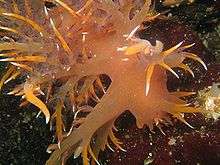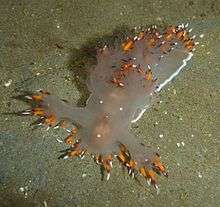Dendronotus iris
Dendronotus iris is a species of sea slug, a dendronotid nudibranch, a shell-less marine gastropod mollusc in the family Dendronotidae.[2][3]
| Dendronotus iris | |
|---|---|
 | |
| Scientific classification | |
| Kingdom: | |
| Phylum: | |
| Class: | |
| (unranked): | clade Heterobranchia clade Euthyneura clade Nudipleura clade Nudibranchia clade Dexiarchia clade Cladobranchia clade Dendronotida |
| Superfamily: | |
| Family: | |
| Genus: | |
| Species: | D. iris |
| Binomial name | |
| Dendronotus iris (Cooper, 1863)[1] | |
Distribution
This species was described from Santa Barbara, California.[1] It can be found along the west coast of North America from Unalaska Island, Alaska to Cabo San Lucas, Baja California.[4][5]
Description

Dendronotus iris can grow to about 30 cm but is usually about 10 cm. The colour of this species is highly variable. It can range from translucent white or gray, to orange or red. It can also have white spots or scattered brownish patches. Distinctive features include the stalk of the rhinophore sheath having a vertical row of three to six small branched processes on its posterior side, and the foot being edged in white, although this may be partially absent in some specimens. The oral veil has four paired processes. The branching gills may be tipped with white, orange, yellow, or purple.[6]
Diet
This species feeds on the burrowing anemone Pachycerianthus fimbriatus.[7]
References
- Cooper J. G. (1863) On new or rare Mollusca inhabiting the coast of California. No. II. Proceedings of the California Academy of Natural Sciences 3: 56-60.
- Rosenberg, G.; Bouchet, P. (2015). Dendronotus iris. In: MolluscaBase (2015). Accessed through: World Register of Marine Species on 2016-01-27.
- Bouchet P. & Rocroi J.-P. (Ed.); Frýda J., Hausdorf B., Ponder W., Valdes A. & Warén A. 2005. Classification and nomenclator of gastropod families. Malacologia: International Journal of Malacology, 47(1-2). ConchBooks: Hackenheim, Germany. ISBN 3-925919-72-4. ISSN 0076-2997. 397 pp.
- Rudman, W.B. (2000). Dendronotus iris (Cooper, 1863). [In] Sea Slug Forum. Australian Museum, Sydney.
- Behrens, D. W., & Hermosillo, A. (2005) Eastern Pacific nudibranchs, a guide to the opisthobranchs from Alaska to Central America. vi + 137 pp., 314 photos. Sea Challengers, Monterey, California, page 94.
- Robilliard G. A. (1970) The systematics and some aspects of the ecology of the genus Dendronotus. The Veliger 12(4): 433-479, pages 446-450.
- Wobber Don R. (1970) A report on the feeding of Dendronotus iris on the anthozoan Cerianthus sp. from Monterey Bay, California. The Veliger 12(4): 383-387, plates 55-57.